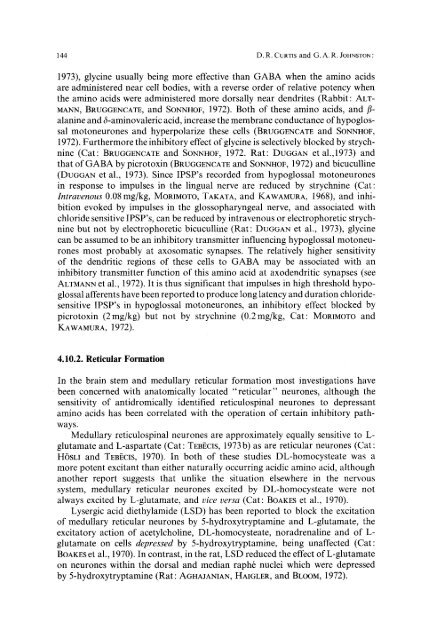Amino acid transmitters in the mammalian central nervous system
Amino acid transmitters in the mammalian central nervous system
Amino acid transmitters in the mammalian central nervous system
You also want an ePaper? Increase the reach of your titles
YUMPU automatically turns print PDFs into web optimized ePapers that Google loves.
144 D.R. CURTIS and G.A.R. JOHNSTON :<br />
1973), glyc<strong>in</strong>e usually be<strong>in</strong>g more effective than GABA when <strong>the</strong> am<strong>in</strong>o <strong>acid</strong>s<br />
are adm<strong>in</strong>istered near cell bodies, with a reverse order of relative potency when<br />
<strong>the</strong> am<strong>in</strong>o <strong>acid</strong>s were adm<strong>in</strong>istered more dorsally near dendrites (Rabbit: ALa'-<br />
MANN, BRUGGENCATE, and SONNHOF, 1972). Both of <strong>the</strong>se am<strong>in</strong>o <strong>acid</strong>s, and flalan<strong>in</strong>e<br />
and b-am<strong>in</strong>ovaleric <strong>acid</strong>, <strong>in</strong>crease <strong>the</strong> membrane conductance of hypoglossal<br />
motoneurones and hyperpolarize <strong>the</strong>se cells (BRUGGENCATE and SONNHOF,<br />
1972). Fur<strong>the</strong>rmore <strong>the</strong> <strong>in</strong>hibitory effect of glyc<strong>in</strong>e is selectively blocked by strychn<strong>in</strong>e<br />
(Cat: BRUGGENCATE and NONNHOF, 1972. Rat: DUGGAN et a1.,1973) and<br />
that of GABA by picrotox<strong>in</strong> (BRUGGENCATE and SONNHOF, 1972) and bicucull<strong>in</strong>e<br />
(DUGGAN et al., 1973). S<strong>in</strong>ce IPSP's recorded from hypoglossal motoneurones<br />
<strong>in</strong> response to impulses <strong>in</strong> <strong>the</strong> l<strong>in</strong>gual nerve are reduced by strychn<strong>in</strong>e (Cat:<br />
Intravenous 0.08 mg/kg, MORIMOTO, TAKATA, and KAWAMURA, 1968), and <strong>in</strong>hibition<br />
evoked by impulses <strong>in</strong> <strong>the</strong> glossopharyngeal nerve, and associated with<br />
chloride sensitive IPSP's, can be reduced by <strong>in</strong>travenous or electrophoretic strychn<strong>in</strong>e<br />
but not by electrophoretic bicucull<strong>in</strong>e (Rat: DUGGAN et al., 1973), glyc<strong>in</strong>e<br />
can be assumed to be an <strong>in</strong>hibitory transmitter <strong>in</strong>fluenc<strong>in</strong>g hypoglossal motoneurones<br />
most probably at axosomatic synapses. The relatively higher sensitivity<br />
of <strong>the</strong> dendritic regions of <strong>the</strong>se cells to GABA may be associated with an<br />
<strong>in</strong>hibitory transmitter function of this am<strong>in</strong>o <strong>acid</strong> at axodendritic synapses (see<br />
ALTMANN et al., 1972). It is thus significant that impulses <strong>in</strong> high threshold hypoglossal<br />
afferents have been reported to produce long latency and duration chloridesensitive<br />
IPSP's <strong>in</strong> hypoglossal motoneurones, an <strong>in</strong>hibitory effect blocked by<br />
picrotox<strong>in</strong> (2mg/kg) but not by strychn<strong>in</strong>e (0.2ms/ks, Cat: MORIMOTO and<br />
KAWAMURA, 1972).<br />
4.10.2. Reticular Formation<br />
In <strong>the</strong> bra<strong>in</strong> stem and medullary reticular formation most <strong>in</strong>vestigations have<br />
been concerned with anatomically located "reticular" neurones, although <strong>the</strong><br />
sensitivity of antidromically identified reticulosp<strong>in</strong>al neurones to depressant<br />
am<strong>in</strong>o <strong>acid</strong>s has been correlated with <strong>the</strong> operation of certa<strong>in</strong> <strong>in</strong>hibitory pathways.<br />
Medullary reticulosp<strong>in</strong>al neurones are approximately equally sensitive to L-<br />
glutamate and L-aspartate (Cat: TEB~:ClS, 1973b)as are reticular neurones (Cat:<br />
H/SSLI and TEB~CIS, 1970). In both of <strong>the</strong>se studies DL-homocysteate was a<br />
more potent excitant than ei<strong>the</strong>r naturally occurr<strong>in</strong>g <strong>acid</strong>ic am<strong>in</strong>o <strong>acid</strong>, although<br />
ano<strong>the</strong>r report suggests that unlike <strong>the</strong> situation elsewhere <strong>in</strong> <strong>the</strong> <strong>nervous</strong><br />
<strong>system</strong>, medullary reticular neurones excited by DL-homocysteate were not<br />
always excited by L-glutamate, and vice versa (Cat: BOAKES et al., 1970).<br />
Lysergic <strong>acid</strong> diethylamide (LSD) has been reported to block <strong>the</strong> excitation<br />
of medullary reticular neurones by 5-hydroxytryptam<strong>in</strong>e and L-glutamate, <strong>the</strong><br />
excitatory action of acetylchol<strong>in</strong>e, DL-homocysteate, noradrenal<strong>in</strong>e and of L-<br />
glutamate on cells depressed by 5-hydroxytryptam<strong>in</strong>e, be<strong>in</strong>g unaffected (Cat:<br />
BOAKES et al., 1970). In contrast, <strong>in</strong> <strong>the</strong> rat, LSD reduced <strong>the</strong> effect of L-glutamate<br />
on neurones with<strong>in</strong> <strong>the</strong> dorsal and median raph6 nuclei which were depressed<br />
by 5-hydroxytryptam<strong>in</strong>e (Rat: AGHAJANIAN, HAIGLER, and BLOOM, 1972).













